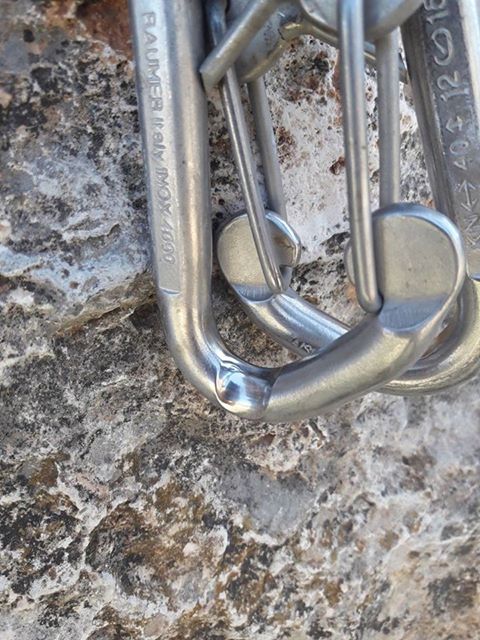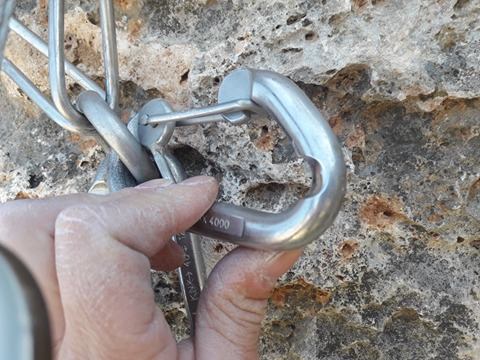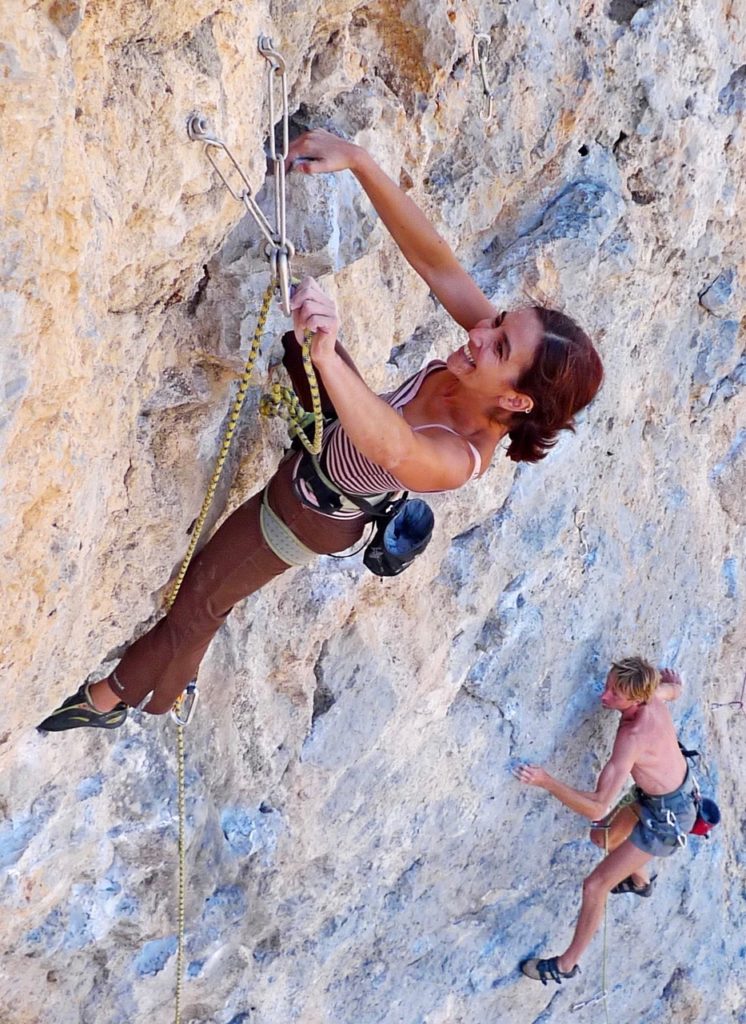[Originally posted on July 07, 2011] Do you feel safe lowering off a half-worn carabiner? No, neither do we. On Kalymnos, despite the best efforts to keep bolts and anchors in perfect shape, worn carabiners are a sign of overuse. Climb after climb, after thousands of ascents bearing all the load, even the heaviest-duty hardware will show signs of wear. However—there is a very simple way to help prolong the life of Kalymnos lower-offs. See below.
Lead climbing
1. Bring along an extra quickdraw.
2. When you reach the anchor, clip your extra quickdraw to the top bolt.
3. Lower from this quickdraw until you are ready to move on to the next climb. For example, if you are with a climbing party of four people and you are all trying this climb, the first climber clips the extra quickdraw to the top bolt at the anchor then lowers from it. The second and third climber also lower from the quickdraw. The fourth (final) climber clips the actual lower-off, removes the extra quickdraw, then strips the rest of the route while lowering.
Top-rope climbing
1. Bring along an extra short quickdraw or screwgate carabiner.
2. Place the quickdraw or screwgate carabiner on the bolt of the anchor in addition to clipping your rope through the fixed carabiner.
3. When you finish top-roping the route, the last climber in your party removes the quickdraw (making sure not to unclip the rope from the anchor!) and lowers from the permanent carabiner(s).
Lastly, if your lower-off is a V-type with two carabiners, always clip always clip both carabiners.

This is what happens when you don’t clip both carabiners. Sector Arginonta Valley, 2018. Photo: Tom Eckert
This takes some of the load off the fixed carabiners at the anchor. If we all make this part of our regular climbing routine and point it out to unaware climbers as well, thousands of ascents later it will have made a huge difference towards the safety and maintenance of routes (both more important than ever as the number of routes on Kalymnos has exceeded 1800 3500).
If you haven’t already been doing this, please start next time you climb. It is best practice and it’s the simplest of ways to show respect and appreciation for the island, the equippers, and the volunteers working hard to keep everybody safe.
***
2018 update
FREE DOWNLOAD: PAGES 22-24 OF THE 2016 KALYMNOS GUIDEBOOK
For photos of the clipping instructions detailed above and more safety guidelines (partner check, stripping very steep pitches, what to do in case of an accident), download pages 22-24 of the latest Kalymnos guidebook. Share with your friends and climbing partners.
***





21 Comments
Yes René, thank you very much. We will replace it soon.
Today at Sea Breeze, the lower off of route ‘Newcomer’ is seriously worn-out (just like the one on the picture).
Can I report this here?
Tom, what is a captive steel carabiners?
Last trip we brought a ton of “leaver ‘biners”. Instead of using a quickdraw to lower off of, which requires ultimate retrieval, just leave a carabiner permanently. Ideally captive steel carabiners would be used.
Hi all,
In my local crag, we always do that but placing a quickdraw and a lock carabiner and not even passing the rope through the fixed carabiner except for the last climber in the party.
Regards
My vote goes for rings! I have so often seen and rapped down from scary biners, but I have rarely seen any worn out rings. I think that re-threading through good rings is safer option than rapping of worn-out biners.
Hi, I vote for the solution with two rings interconnected with a maillon.
The ONLY drawback on the carabiner solution is money. Climbers will drop $150/yr on shoes, $18 on 1 QD’s, and countless $ on beer and fancy protein cookies. How about for each 100 routes climbed each person donates an anchor biner or two. That’s the real solution. We all need to give back a little more from what we take.
(funny the submision password was “GREED” :-) )
Well, all the wear and tear is when people ar lovered down, so adding an extra carabiner that takes that load is something everyone should do. -With the backup use of those already fixed ancors.
So when you are about to take down the rope you should rather rappell/abseil down. I.e ther will be no load on the fixed ancor afterwards when pulling down the rope.
How to organize the rope for abseiling? -If you don’t know: Take a climbing course…
@ Emanuele
Rings are “very inconvenient”??? In what way? Here in the UK I’m used to re-threading at the top of a sports route. It takes 2 minutes to do. How is that very inconvenient? Especially when it’s preserving the routes for far longer use?!
@Dave Musgrove – if people are worried about the rope length then once you’ve brought the rope through the rings, you can of course simply retie your original figure of 8 back into the harness rather than come down on a karabiner and keep the full length of your rope? Takes an extra 30seconds to do….
Climbers converge in a limited number of places at night. A few posters in strategic locations might be a helpful reminder. Glaros, the climbing shops etc.
Regards
I think climbers are too cheap. They deserve what they get.
C’on what the hell to replace a biner?
Rings are a good solution, but they are inconvenient. Very unconvenient.
Do not replace carabiners. Leave worn biners as they are.
Climbers are human being. They have a brain. They must understand their life is worth a biner.
Free Ring: Security problem during manipulation, potential loss of rope length (and time consuming)
Double Carabiners: Cost and potential rope damage (when clipping only one carabiner after asymmetric erosion)
Single Carabiner + QD: It’s my preferred – you MUST clip both QD and the carabiner
the two rings (with or without inox maillons) is the most logical solution!!!! if someone does not know how to manipulate the rappel situation must either go for a elementary rock-climbing course or go to sea and have fun….
@dave if someone is unable to untie and rethread without using double rope (and losing potentially precious rope meters) then I reckon what Halvan said applies here too, back to the gym that is.
double carabiners are expensive and can cause rope damage once they begin to be eaten (on one side only) and people clip only one of them (yes, that happens). What’s wrong with rings, they last forever and may even get you to turn around after clipping the chain and enjoy the view. Agree with Lee btw.
Like most climbers I think that the double Inox carabiner is best for ease of use and general safety but the cost implication is huge.
I run the bolt fund in Yorkshire, here in the UK, and for many years our lower-off of choice (and cost necessity) has been two single rings set one slightly above the other to avoid twisting. Climbers soon get used to the safe methods of untying and re-threading. However many climbers do this by pulling through a loop of rope first, tying a figure of eight and then clipping in before untying from their waist belt. This leaves a tail of around two to three metres of spare rope. This is rarely a problem on our short routes in the UK but in Kaly many routes are 35 metres or even longer and getting down is often only on the stretch of the rope from the current clip belays. Using rings on such routes may well increase the number of climbers being dropped off the end of the rope.
If you intend to change to this method Aris I suggest it is only on shorter routes of less than 25 metres. I am a little worried about this on my own route Xerxes on Spartan Wall for which only rings were available at the time.
Dave
I would never lower off a single permanent carabiner, but that’s just based on the safety ethics of where I learned to climb – it’s simply what I’ve been taught and I guess that differs between countries and individuals. Double carabiners would be nice, but there’s always the question of costs. A free ring is ok, as you can still lower off your own gear and would only need to use the ring for the last person in the party, and if you don’t know how to properly lower off from a ring, you shouldn’t even be up there in the first place imo.
It is a good idea to speak about this issue; most of climbers don’t really care about belay overuse and this could be very dramatic if nobody doesn’t.
The use of ring proposed by Bruno allows to reduce the overuse but is also a cause of mistake during the manipulation. There is also a danger with the permanent carabiner, especially when you go higher to the belay and with twisted ropes (it could happen…); inverted double permanent carabiners overcome this danger (but expensive). So, there is no best solution. I would say that permanent carabiners is more Kaly’ style than ring. I agree with the solution proposed by this article and advice the inverted double permanent carabiners since there are a lot of people doing top rope. Just be careful when you remove the quickdraw, do not climb higher to the belay and do not let the quickdraw fall on the rope until the belayer.
Anyway, belays have to be checked and changed regularly, thank you Aris.
Hi guys
Clip-and-lower stations are terrific for usability and from a security standpoint, they don’t introduce appreciably more risk despite what people might think. However, in extreme high-traffic environments, a free-spinning ring is the very best option in terms of maintenance. Because the ring is able to spin, one section of the metal is not being continually worn, and the wear is spread over the entire ring. They last much, much longer.
If it is the desire to keep the glorious clip-and-lower stations, it is my suggestion that the carabiner(s) are attached via mallions (rather than directly to the ring) to allow for easy replacement.
As a related side-issue, I am also in favour of withdrawing Municipality funding for new routes. This was useful in the birth phase of Kalymnos climbing as it encouraged rapid development, but we are beyond this phase now. As elsewhere in the world, motivated new routers will fund their own routes. We should see the number of new routes per year decrease to a more sensible level, and the quality of routes keeping a high standard. Municipality funding should now be focused on maintenance of the existing routes via a rolling upgrade of hardware and anchors (with a shift to glue-in’s) island-wide.
Lee Cujes
Safer Cliffs Australia (Rebolting Organisation) http://www.safercliffs.org
Upskill Climbing http://www.upskillclimbing.com
For my part, Bruno is completely right.
carabiner lower off is a bad solution for security (Aris do not accept this … but it is the reality), now I don’t put carabiners at the belays but only a free ring (free on the bolt “symptom of overuse” is perhaps a reality … but in a very long time :-))